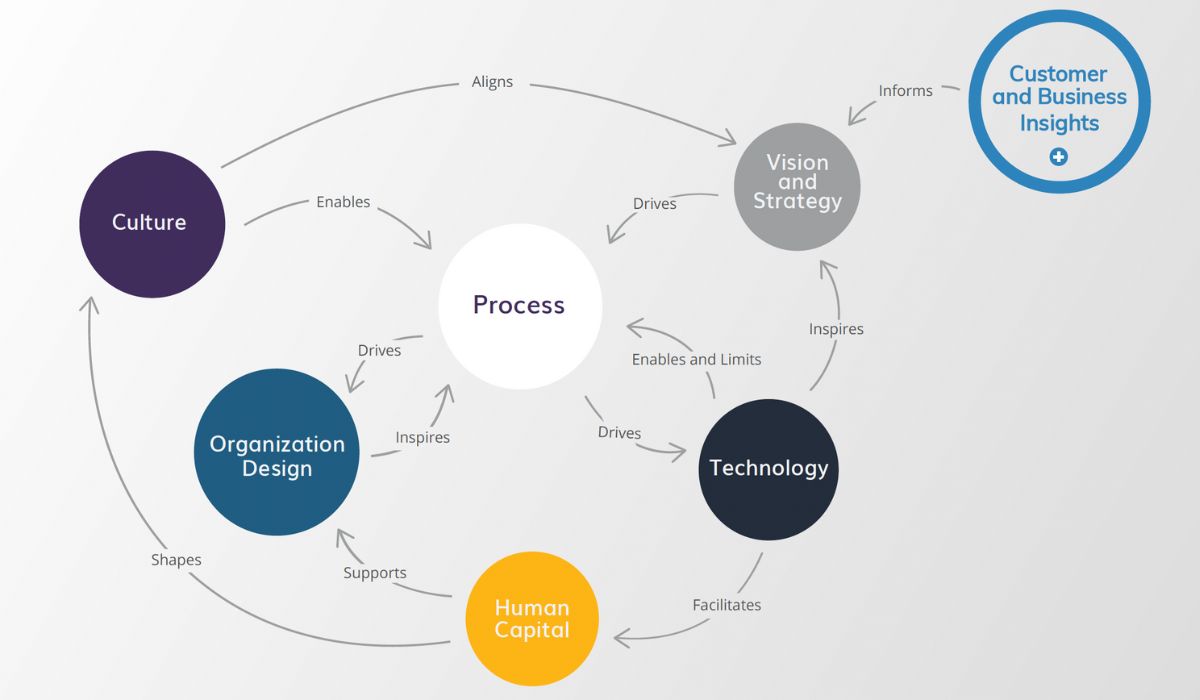To survive and thrive in today’s dynamic business environment, companies must constantly adapt to new circumstances. Organizations engage in enterprise transformation to adapt to the changing needs of their industries. It entails a thorough revision of all operational, technological, and cultural components to propel creativity, productivity, and expansion. This essay delves into what matters most and how to go about it while transforming a business.
Understanding Enterprise Transformation
To transform an enterprise is to make significant changes to its organizational design, operations, and approach. This requires adjusting to market shifts, rethinking business structures, improving customer experiences, and incorporating new technologies. The major goal is to enhance responsiveness, creativity, and productivity.
The Key Pillars of Enterprise Transformation
Vision and Strategy
To successfully navigate change, businesses need a clear and well-defined vision. It entails formulating strategic objectives, identifying market trends, and outlining the desired future condition of the firm. The strategy must be in line with the company’s objectives and take into account changes in the market and in technology.
Leadership and Change Management
Leadership is crucial to initiating and maintaining change. Leaders need to motivate their teams, share the vision with everyone, and keep everyone on the same page in order to successfully adapt to change. Communication plans, training, and staff buy-in are all examples of change management tactics necessary for a successful shift.
Technology and Innovation
The significance of technology in the modernization of businesses is crucial. Artificial intelligence (AI), cloud computing (cloud computing), and data analytics are just a few examples of the cutting-edge solutions that can improve operational efficiency, decision-making, and consumer experiences. Long-term success requires investing in the proper technologies and fostering a culture of innovation.
Culture and People
Changing the culture of a company is essential while attempting to modernize it. It entails giving workers a voice, creating a setting that rewards teamwork and flexibility, and promoting an outlook that welcomes innovation and adaptation. The success of any organizational transformation depends heavily on the participation and buy-in of all staff members.
Strategies for Successful Enterprise Transformation
Assess Current State and Define Objectives
It is essential for the business to know where it stands right now. The strengths, shortcomings, and potential improvement areas of a company can be better understood when a thorough evaluation of its current procedures, technology, and culture has been conducted. Having well-defined goals and key performance indicators is crucial for tracking development.
Develop a Roadmap
Make a detailed plan defining the processes and major milestones of the transformation process. There should be no ambiguity on the timetable, roles, or allocation of resources outlined in this plan. It needs to be malleable enough to adjust to whatever comes up during the shift.
Embrace Agile Methodologies
Businesses can become more flexible and responsive with the help of agile approaches. Through the use of agile frameworks, decisions may be made and refined rapidly. This method encourages creative thinking and quickens the pace of change.
Invest in the Right Technologies
It is crucial for businesses to invest in technology that support their goals. Whether it’s artificial intelligence (AI) for process automation or data analytics (DA) for insights, spending money on the proper technology can boost productivity and creativity.
Engage and Empower Employees
The employees are the most important part of the change process. Get people involved by teaching them what they need to know, creating an atmosphere where they feel comfortable asking questions, and giving them plenty of chances to offer input. If workers are given more responsibility, they are more likely to drive and maintain the change.
Challenges and Risks
It’s not easy to convert a business. The difficulty of integrating new technologies, as well as people’s natural reluctance to change and a lack of available resources, are also frequent problems. Additionally, the danger of disturbance to ongoing operations and probable failure in reaching intended goals are inherent considerations.
Conclusion
Business transformation is a high-stakes strategic activity that calls for forethought, leadership, and acceptance of change. Organizations can successfully negotiate the complexity of transformation if they prioritize vision, leadership, technology, culture, and effective strategies. Embracing innovation, adjusting to market changes, and establishing a culture of agility are crucial for organizations wanting to prosper in today’s dynamic business climate.
Also Read: Enterprise Transformation: Revamping Businesses for the Future.
Common Questions About Organizational Change
What is enterprise transformation?
To convert an enterprise is to make significant changes to its organizational design, operations, and methods. To boost innovation, efficiency, and growth, businesses must adopt new technology, rethink their business models, and adjust to shifting market conditions.
Why is enterprise transformation important?
Companies must adapt quickly to maintain their competitive edge in today’s dynamic business environment. Organizational transformation is the key to long-term success and sustainability because it enables businesses to respond to changes in the market, innovate, increase efficiency, and satisfy the ever-evolving demands of their customers.
What are the key pillars of enterprise transformation?
The foundations of an effective business transformation are:
- Direction and Plan
- Engineering and New Ideas
- Societies and Individuals
When it comes to changing a company, how important is technology?
Technology is a vital component in enterprise change. Embracing innovative solutions like AI, cloud computing, and data analytics may greatly boost operational efficiency, decision-making, and customer experiences, driving the transformation process forward.
What are the keys to a successful corporate transformation for a company?
To successfully restructure an organization, you need:
- Identifying and articulating one’s goals with precision
- Creation of a clear plan of action
- Adopting an Agile Approach
- Spending on appropriate technologies is essential.
- Staff participation and autonomy











